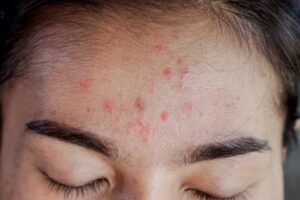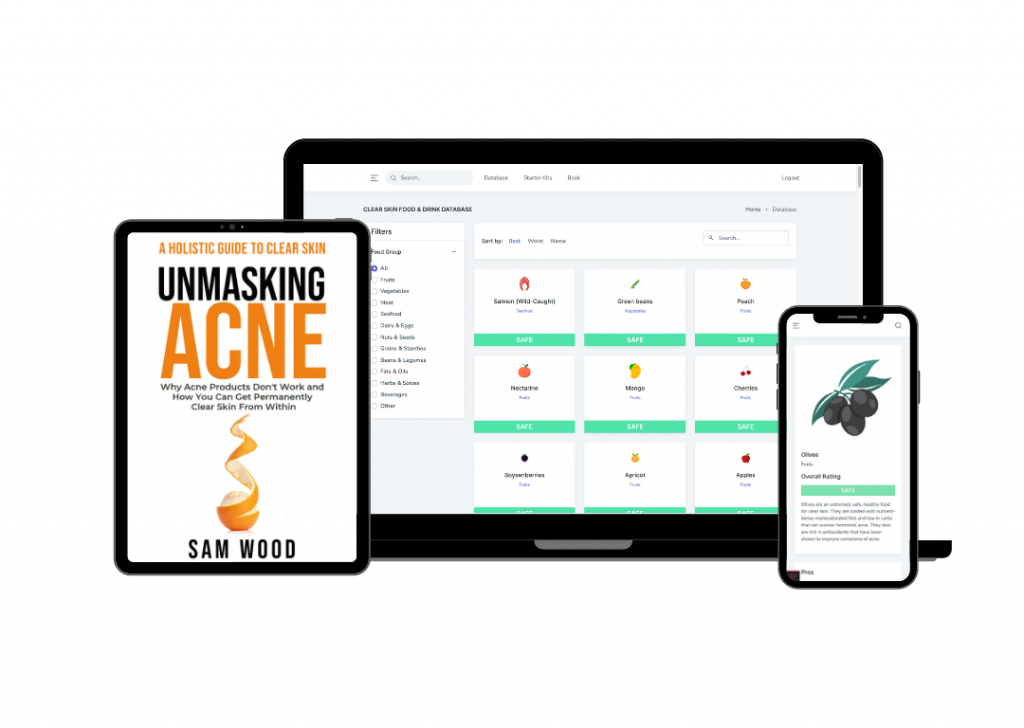We all know the dreaded feeling of going to sleep with clear skin and waking up with a third eye growing between your eyebrows.
Not only is this annoying and almost always pops up at the most inconvenient times, but it can also be quite painful, depending on the severity of the lesion.
But what exactly is the type of acne that shows up between the eyebrows, and what can you do to get rid of it?
Types of Acne Between Your Eyebrows
Acne is generally categorized as non-inflammatory and inflammatory. And both of these types can appear in all the smallest nooks and crannies on your face, including between your eyebrows.
Here are some most common types of acne that usually appear between the eyebrows and what triggers them:
Closed Comedones
Closed comedones are those tiny white bumps that can’t be popped and appear in oily areas of the face, such as the forehead, chin, and cheeks.
Caused by the buildup of sebum and covered with a thin layer of skin, closed comedones occur when the opening is unable to dilate and let the cellular debris that’s accumulated inside the pore out.
Open Comedones
Open comedones, or blackheads, form in the same way as closed comedones, but because the pore is open at the surface, the contents, which include sebum, dead skin cells, and white blood cells, oxidize when exposed to air, turning the tip black.
Although non-problematic and usually non-inflammatory, both closed and open comedones have the potential to turn into inflamed pimples.
Pustules
Pustules are angry, red spots that have a white tip in the center filled with inflammatory cellular debris or pus.
Pustules tend to show up in oily areas of the face and body; however, they aren’t difficult to treat and rarely leave scars behind.
The only instance where a pustule might cause a scar is if you attempt to pop it and push the infection deep beneath the skin’s surface, causing damage to the surrounding tissue.
Papules
Papules or blind spots are inflammatory acne lesions that appear as small, red bumps on the skin without a visible pus-filled center.
Although they can be sore, touching or picking at papules can cause them to rupture, leading to the formation of scars.
Cysts
Although cysts form in clusters in other areas of the face and body, they usually appear as isolated spots between the eyebrows and tend to go away on their own or with a mild spot treatment.
Cysts are the most serious type of pimple that can form here, and these lesions are large, deep, and can be rather painful and uncomfortable.
Pustule-Like Rash
Slightly different than a regular pustule, a pustule-like rash is usually a form of folliculitis, which is an infection of the hair follicles marked by small, red bumps that are filled with pus and have the tendency to itch.
This type of rash can be caused by shaving too closely, using dirty or dull razors, or wearing tight-fitting gadgets like helmets and caps that can cause friction and lead to more serious issues such as sores.
What Causes Acne Between Eyebrows?
No matter the type, acne is a complex issue that can be caused by a number of different factors, both internal and external.
Some of the most common triggers for acne between eyebrows include:
Dirty Hair
Greasy, dirty hair can contribute to the development of acne between the eyebrows, especially if you have bangs that hang down over the forehead and come into close contact with the skin.
Typically the dirt, oil, and bacteria that accumulate on your hair and scalp will eventually make their way down to your brows, clogging pores and causing breakouts.
Sweat
Sweat is another potential culprit of acne between the eyebrows, as this substance has the ability to change the skin’s pH, leading to a perfect environment for bacteria to thrive and multiply.
Sweat can also cause the overgrowth of yeast that already resides on the skin, which can further contribute to the development of blemishes.
Skincare Products
Comedogenic skincare products that contain ingredients like oils, butters, and waxes, can cause the formation of acne between the eyebrows by clogging the pores and creating a perfect mixture for bacteria to thrive and multiply.
Haircare Products
Haircare products also tend to contain comedogenic ingredients that remain on the hair for a long time, rubbing off on the skin and clogging the pores, eventually leading to acne.
Ingrown Hairs
Ingrown hairs can lead to larger papules or even cysts because they cause the hair follicle to become inflamed, eventually leading to a rupture and infection spilling outside the pore lining.
This usually happens if you shave or wax your brows, as the hair can grow back in the wrong direction and become embedded in the skin.
Waxing
Waxing between the eyebrows can often lead to pustule-like rashes or folliculitis, as this method of hair removal can damage the skin and hair follicles if not done correctly.
Additionally, wax can be rather unsanitary, and while salons should get rid of their wax after each use, this isn’t always the case, which means you could be exposing yourself to bacteria that could cause breakouts and rashes.
Hormones
Imbalanced hormones and hormonal conditions such as polycystic ovarian syndrome (PCOS) can lead to the formation of acne, especially larger cysts in various areas of the face and body.
Therefore, if you frequently experience cysts in unlikely areas like between the eyebrows, this could be due to an underlying condition.
How To Treat Acne Between Eyebrows?
One of the most efficient treatments to soothe acne overnight is to use pimple patches, as these thin hydrocolloid dressings will help draw out pus and oil while also protecting the area from further irritation.
Additionally, many pimple patches, like the Aeno Hydrocolloid Acne Patches, contain salicylic acid, an ingredient that helps exfoliate the skin and prevent new breakouts from forming, as well as soothing and anti-inflammatory components that help reduce the redness and swelling surrounding the pimple after only a few hours.
How To Prevent Acne Between Eyebrows?
Acne between eyebrows is a common occurrence, but luckily, it’s not a huge cause of concern as this area is unlikely to scar, and pimples here are generally isolated and mild.
That being said, no one wants to deal with breakouts of any kind, so here are a few simple habits you should introduce into your daily skincare routine to prevent acne:
Improve Your Hygiene & Cleanliness
Besides regularly washing your face and hair, it’s also important to maintain cleanliness in all areas where you tend to rest your face, like your pillowcases, towels, and mobile phone.
Washing your pillowcases and towels regularly is definitely one of the most important things you can do to prevent acne between your eyebrows and anywhere else on the face and body, as these two harbor bacteria that can easily make their way onto your skin.
Additionally, it’s also a good idea to invest in a silk pillowcase, as this material is less likely to accumulate bacteria and dirt and is also gentler on the skin, especially on active acne.
Thoroughly Remove Your Makeup
Makeup products such as foundation, concealer, powder, and even brow products often contain comedogenic or pore-clogging ingredients that lead to the formation of acne between the eyebrows.
Which is why, besides using acne-safe makeup products, it’s also important to thoroughly remove your makeup before going to bed at night.
Use Non-Comedogenic Skincare Products
Much like makeup, skincare products often contain comedogenic ingredients that can clog pores and lead to the formation of pimples.
However, the complicated thing about these ingredients is that they’re not necessarily bad, and emollients, oils, and butters can help protect the skin from becoming dry, cracked, and itchy, so they definitely serve a purpose in skincare products.
But since they can be problematic for acne-prone skin, it’s essential to avoid products that contain these components.
Exfoliate Regularly
Exfoliation is an essential step in a good skincare routine, and it’s a process that helps remove dead skin cells, dirt, and oil that can lead to clogged pores and acne.
Therefore, by exfoliating two to three times a week, you can help prevent the formation of pimples between your eyebrows, as well as anywhere else on the face and body.
Pay Attention to Your Diet
An inflammatory diet can be one of the main causes of pimples, as certain foods can trigger the release of hormones that stimulate the sebaceous glands and make them produce more oil that then goes on to clog the pores.
Therefore, if you want to help prevent acne between your eyebrows or anywhere else on the face and body, as well as stabilize certain conditions that can make breakouts worse, it’s important to pay attention to your diet and include more nourishing foods that help protect the cells from damage as well as balance out hormone levels.
However, diet can be a complicated topic, and what works for one person might not work for another, so you definitely need to do thorough research on the subject in order to find out what kind of foods you should include or avoid in your diet.
A good place to start is GoodGlow’s ebook, which is created specifically for those struggling with acne and contains valuable information on how to balance your hormones and reduce active inflammation on the skin through diet.
Does Tea Tree Oil Help Acne Between Eyebrows?
Tea tree oil is a popular remedy for acne, thanks to its antibacterial and anti-inflammatory properties that can reduce redness and swelling associated with pimples.
Additionally, tea tree oil is also thought to help reduce enlarged pores by balancing out oil production.
However, while tea tree oil is generally considered safe, it can cause irritation in some people, which is why it’s important to use tea tree oil in adequately formulated products rather than resorting to DIY mixtures that probably don’t have the right pH for the skin and can actually do more harm than good.
Does Sulfur Help Acne Between Eyebrows?
Sulfur is one of the best ingredients for acne-prone skin, as it works to instantly reduce redness, irritation, and swelling, as well as dry out pimples so they can heal faster.
Additionally, sulfur also has keratolytic properties, which means that it can help break down the bonds between skin cells, thus preventing them from clogging the pores and leading to breakouts.
Lastly, sulfur is easy to use, doesn’t cause major side effects, and is generally well tolerated by all skin types, including sensitive skin.

